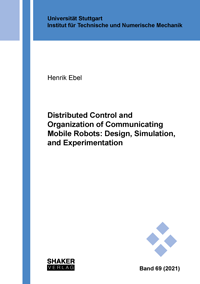
Shop : Details
Shop
Details
48,80 €ISBN 978-3-8440-8172-5Softcover174 pages69 figures258 g21 x 14,8 cmEnglishThesis
August 2021
Henrik Ebel
Distributed Control and Organization of Communicating Mobile Robots: Design, Simulation, and Experimentation
Leveraging the communication-based cooperation of multiple robotic systems has the potential to significantly further the state of the art of what is achievable with robotic automation. Therefore, reconfigurable robotic networks have come to the attention of research and industry. However, despite the potential to increase flexibility, robustness, and performance, robotic networks are not yet in widespread application, with many research challenges remaining. Hence, to better understand and subsequently overcome these challenges, distributed robotics is still in a state where it can benefit significantly from research that tackles well-defined benchmark problems. Consequently, this thesis faces the challenges of distributed robotics at the example of a cooperative transportation task. In the task, omnidirectional mobile robots cooperate to maneuver polygonal objects purely by pushing forces and in a completely self-reliant manner. The task is found to be a formidable benchmark problem since it raises all major challenges of the field. The dissertation discusses all aspects of the task in an encompassing manner, not only including the design of the employed control and organization methods, but also the software architecture and even the custom robotic hardware employed. Results from simulations and real-world hardware experiments show that the proposed scheme is of unprecedented versatility, putting into practice all major promises of distributed robotics, including plug-and-play control for online reconfigurations of the robotic network.
Die kommunikationsbasierte Kooperation mehrerer robotischer Systeme hat das Potenzial, den Horizont dessen, was mit robotischer Automation erreichbar ist, nachhaltig zu erweitern. Daher rücken dynamisch anpassbare robotische Netzwerke zunehmend in den Fokus der Forschung, die in den letzten Jahrzehnten zuvorderst die Verbesserung einzelner Roboter vorangetrieben hat. Dies geht mit der Hoffnung einher, die erreichbare Flexibilität, Robustheit und Leistungsfähigkeit gegenüber zentralisierten Ansätzen entscheidend positiv zu beeinflussen. Trotz dieser charakteristischen, erwarteten Vorteile sind robotische Netzwerke jedoch noch vorwiegend Gegenstand von Forschung und Forschungsvisionen und noch nicht in die Breite der Anwendung gelangt. Infolgedessen ist die verteilte Robotik in einem Stadium, in dem sich Fortschritte durch zielgerichtete Forschung anhand klar definierter Modellprobleme erzielen lassen. Aus diesem Grund stellt sich diese Dissertation den Herausforderungen der verteilten Robotik anhand einer kooperativen Transportaufgabe. Dabei sollen omnidirektionale mobile Roboter polygonale Objekte komplett selbstständig und nur durch Schubkräfte transportieren. Diese Aufgabe ist hervorragend als Modellproblem geeignet, da sie alle für das Forschungsfeld charakteristischen Herausforderungen mit sich bringt. Die Dissertationsschrift behandelt alle Aspekte der Aufgabe auf umfassende Art und Weise. So werden neben den Organisations- und Regelverfahren auch die zugrundeliegende verteilte Programmarchitektur sowie sogar die eingesetzten, extra für die Forschung in der verteilten Robotik entwickelten mobilen Roboter entworfen und untersucht. Eine ausführliche simulative und experimentelle Erprobung zeigt die Leistungsfähigkeit und Vielseitigkeit der entwickelten Ansätze.
Die kommunikationsbasierte Kooperation mehrerer robotischer Systeme hat das Potenzial, den Horizont dessen, was mit robotischer Automation erreichbar ist, nachhaltig zu erweitern. Daher rücken dynamisch anpassbare robotische Netzwerke zunehmend in den Fokus der Forschung, die in den letzten Jahrzehnten zuvorderst die Verbesserung einzelner Roboter vorangetrieben hat. Dies geht mit der Hoffnung einher, die erreichbare Flexibilität, Robustheit und Leistungsfähigkeit gegenüber zentralisierten Ansätzen entscheidend positiv zu beeinflussen. Trotz dieser charakteristischen, erwarteten Vorteile sind robotische Netzwerke jedoch noch vorwiegend Gegenstand von Forschung und Forschungsvisionen und noch nicht in die Breite der Anwendung gelangt. Infolgedessen ist die verteilte Robotik in einem Stadium, in dem sich Fortschritte durch zielgerichtete Forschung anhand klar definierter Modellprobleme erzielen lassen. Aus diesem Grund stellt sich diese Dissertation den Herausforderungen der verteilten Robotik anhand einer kooperativen Transportaufgabe. Dabei sollen omnidirektionale mobile Roboter polygonale Objekte komplett selbstständig und nur durch Schubkräfte transportieren. Diese Aufgabe ist hervorragend als Modellproblem geeignet, da sie alle für das Forschungsfeld charakteristischen Herausforderungen mit sich bringt. Die Dissertationsschrift behandelt alle Aspekte der Aufgabe auf umfassende Art und Weise. So werden neben den Organisations- und Regelverfahren auch die zugrundeliegende verteilte Programmarchitektur sowie sogar die eingesetzten, extra für die Forschung in der verteilten Robotik entwickelten mobilen Roboter entworfen und untersucht. Eine ausführliche simulative und experimentelle Erprobung zeigt die Leistungsfähigkeit und Vielseitigkeit der entwickelten Ansätze.
Keywords: robotics; distributed robotics; robotic network; communication; model predictive control; optimization; reorganization; simulation; experiments; distributed control
Schriften aus dem Institut für Technische und Numerische Mechanik der Universität Stuttgart
Edited by Prof. Dr.-Ing. Peter Eberhard, Stuttgart
Volume 2021,69
Available online documents for this title
DOI 10.2370/9783844081725
You need Adobe Reader, to view these files. Here you will find a little help and information for downloading the PDF files.
Please note that the online documents cannot be printed or edited.
Please also see further information at: Help and Information.
Please also see further information at: Help and Information.
| Document |  | Document | ||
| Type |  | |||
| Costs |  | 36,60 € | ||
| Action |  | Purchase in obligation and download the file | ||
| Document |  | Table of contents | ||
| Type |  | |||
| Costs |  | free | ||
| Action |  | Download the file | ||
User settings for registered online customers (online documents)
You can change your address details here and access documents you have already ordered.
User
Not logged in
Export of bibliographic data
Shaker Verlag GmbH
Am Langen Graben 15a
52353 Düren
Germany
Am Langen Graben 15a
52353 Düren
Germany
Mon. - Thurs. 8:00 a.m. to 4:00 p.m.
Fri. 8:00 a.m. to 3:00 p.m.
Fri. 8:00 a.m. to 3:00 p.m.
Contact us. We will be happy to help you.



